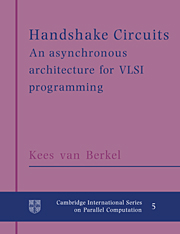Book contents
- Frontmatter
- Contents
- Foreword
- Preface
- 0 Introduction
- 1 Introduction to Tangram and handshake circuits
- 2 Examples of VLSI programs
- 3 Handshake processes
- 4 Handshake circuits
- 5 Sequential handshake processes
- 6 Tangram
- 7 Tangram → handshake circuits
- 8 Handshake circuits → VLSI circuits
- 9 In practice
- A Delay insensitivity
- B Failure semantics
- Bibliography
- Glossary of symbols
- Index
4 - Handshake circuits
Published online by Cambridge University Press: 14 January 2010
- Frontmatter
- Contents
- Foreword
- Preface
- 0 Introduction
- 1 Introduction to Tangram and handshake circuits
- 2 Examples of VLSI programs
- 3 Handshake processes
- 4 Handshake circuits
- 5 Sequential handshake processes
- 6 Tangram
- 7 Tangram → handshake circuits
- 8 Handshake circuits → VLSI circuits
- 9 In practice
- A Delay insensitivity
- B Failure semantics
- Bibliography
- Glossary of symbols
- Index
Summary
Introduction
The most interesting operation on handshake processes is parallel composition. Parallel composition is defined only for connectable processes. Connectability of handshake processes captures the idea that ports form the unit of connection (as opposed to individual port symbols), and that a passive port can only be connected to a single active port and vice versa. A precise definition will be given later.
The communication between connectable handshake processes is asynchronous: the sending of a signal by one process and the reception of that signal by another process are two distinct events. Asynchronous communication is more complicated than synchronized communication, because of the possible occurrence of interference. The concept of interference with respect to voltage transitions has been mentioned in Section 0.1. Interference with respect to symbols occurs when one process sends a symbol and the other process is not ready to receive it. The receptiveness of handshake processes and the imposed handshake protocol exclude the possibility of interference. We are therefore allowed to apply the simpler synchronized communication in the definition of parallel composition of handshake processes.
Another complication is, however, the possibility of divergence: an unbounded amount of internal communication, which cannot be distinguished externally from deadlock. From an implementation viewpoint divergence is undesirable: it forms a drain on the power source, without being productive.
The external behavior of the parallel composition of connectable P and Q will be denoted by P ∥ Q, which is again a handshake process.
- Type
- Chapter
- Information
- Handshake CircuitsAn Asynchronous Architecture for VLSI Programming, pp. 73 - 88Publisher: Cambridge University PressPrint publication year: 1994



